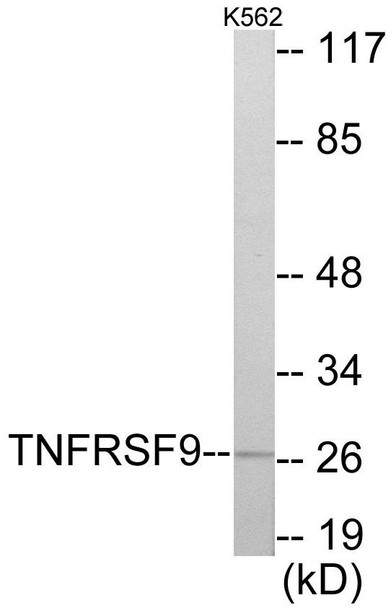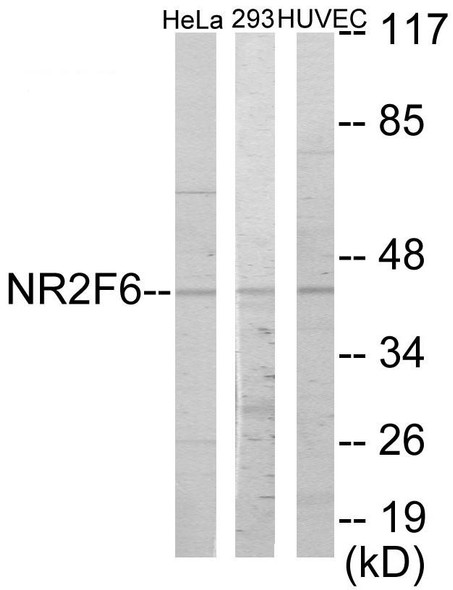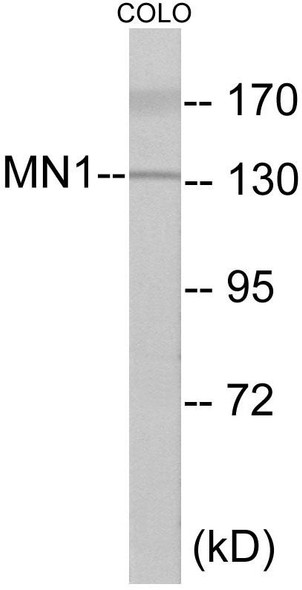Description
TNFRSF9 Colorimetric Cell-Based ELISA
The TNFRSF9 Colorimetric Cell-Based ELISA Kit is specially designed to quantify levels of TNFRSF9 in cell lysates and tissue homogenates. This kit offers high sensitivity and specificity, ensuring accurate and reliable results for a variety of research applications.TNFRSF9, also known as CD137 or 4-1BB, is a member of the tumor necrosis factor receptor superfamily and is involved in regulating immune responses and inflammation. It plays a crucial role in the activation and proliferation of T cells, making it a valuable target for studying autoimmune diseases, cancer immunotherapy, and other immune-related disorders.
With this TNFRSF9 Colorimetric Cell-Based ELISA Kit, researchers can accurately measure TNFRSF9 levels in biological samples, allowing for in-depth analysis and further understanding of the role this protein plays in various physiological and pathological processes. This kit is a valuable tool for researchers looking to advance their studies in immunology, oncology, and other fields related to immune regulation and inflammation.
| Product Name: | TNFRSF9 Colorimetric Cell-Based ELISA |
| Product Code: | CBCAB01068 |
| ELISA Type: | Cell-Based |
| Target: | TNFRSF9 |
| Reactivity: | Human |
| Dynamic Range: | > 5000 Cells |
| Detection Method: | Colorimetric 450 nmStorage/Stability:4°C/6 Months |
| Format: | 96-Well Microplate |
The TNFRSF9 Colorimetric Cell-Based ELISA Kit is a convenient, lysate-free, high throughput and sensitive assay kit that can detect TNFRSF9 protein expression profile in cells. The kit can be used for measuring the relative amounts of TNFRSF9 in cultured cells as well as screening for the effects that various treatments, inhibitors (ie siRNA or chemicals), or activators have on TNFRSF9.
Qualitative determination of TNFRSF9 concentration is achieved by an indirect ELISA format. In essence, TNFRSF9 is captured by TNFRSF9-specific primary antibodies while the HRP-conjugated secondary antibodies bind the Fc region of the primary antibody. Through this binding, the HRP enzyme conjugated to the secondary antibody can catalyze a colorimetric reaction upon substrate addition. Due to the qualitative nature of the Cell-Based ELISA, multiple normalization methods are needed:
| 1. | A monoclonal antibody specific for human GAPDH is included to serve as an internal positive control in normalizing the target absorbance values. |
| 2. | Following the colorimetric measurement of HRP activity via substrate addition, the Crystal Violet whole-cell staining method may be used to determine cell density. After staining, the results can be analysed by normalizing the absorbance values to cell amounts, by which the plating difference can be adjusted. |
| Database Information: | Gene ID: 3604, UniProt ID: Q07011, OMIM: 602250, Unigene: Hs.654459 |
| Gene Symbol: | TNFRSF9 |
| Sub Type: | None |
| UniProt Protein Function: | TNFRSF9: Receptor for TNFSF9/4-1BBL. Possibly active during T cell activation. |
| UniProt Protein Details: | Protein type:Membrane protein, integral; Receptor, misc. Chromosomal Location of Human Ortholog: 1p36 Cellular Component: extracellular space; integral to plasma membrane; external side of plasma membrane Molecular Function:cytokine binding; receptor activity Biological Process: negative regulation of cell proliferation; apoptosis |
| NCBI Summary: | The protein encoded by this gene is a member of the TNF-receptor superfamily. This receptor contributes to the clonal expansion, survival, and development of T cells. It can also induce proliferation in peripheral monocytes, enhance T cell apoptosis induced by TCR/CD3 triggered activation, and regulate CD28 co-stimulation to promote Th1 cell responses. The expression of this receptor is induced by lymphocyte activation. TRAF adaptor proteins have been shown to bind to this receptor and transduce the signals leading to activation of NF-kappaB. [provided by RefSeq, Jul 2008] |
| UniProt Code: | Q07011 |
| NCBI GenInfo Identifier: | 728738 |
| NCBI Gene ID: | 3604 |
| NCBI Accession: | Q07011.1 |
| UniProt Related Accession: | Q07011,AAB34924 |
| Molecular Weight: | 27,899 Da |
| NCBI Full Name: | Tumor necrosis factor receptor superfamily member 9 |
| NCBI Synonym Full Names: | tumor necrosis factor receptor superfamily, member 9 |
| NCBI Official Symbol: | TNFRSF9 |
| NCBI Official Synonym Symbols: | ILA; 4-1BB; CD137; CDw137 |
| NCBI Protein Information: | tumor necrosis factor receptor superfamily member 9; CD137 antigen; T cell antigen ILA; T-cell antigen ILA; 4-1BB ligand receptor; homolog of mouse 4-1BB; receptor protein 4-1BB; T-cell antigen 4-1BB homolog; induced by lymphocyte activation (ILA); interleukin-activated receptor, homolog of mouse Ly63 |
| UniProt Protein Name: | Tumor necrosis factor receptor superfamily member 9 |
| UniProt Synonym Protein Names: | 4-1BB ligand receptor; CDw137; T-cell antigen 4-1BB homolog; T-cell antigen ILA; CD_antigen: CD137 |
| UniProt Gene Name: | TNFRSF9 |
| UniProt Entry Name: | TNR9_HUMAN |
| Component | Quantity |
| 96-Well Cell Culture Clear-Bottom Microplate | 2 plates |
| 10X TBS | 24 mL |
| Quenching Buffer | 24 mL |
| Blocking Buffer | 50 mL |
| 15X Wash Buffer | 50 mL |
| Primary Antibody Diluent | 12 mL |
| 100x Anti-Phospho Target Antibody | 60 µL |
| 100x Anti-Target Antibody | 60 µL |
| Anti-GAPDH Antibody | 60 µL |
| HRP-Conjugated Anti-Rabbit IgG Antibody | 12 mL |
| HRP-Conjugated Anti-Mouse IgG Antibody | 12 mL |
| SDS Solution | 12 mL |
| Stop Solution | 24 mL |
| Ready-to-Use Substrate | 12 mL |
| Crystal Violet Solution | 12 mL |
| Adhesive Plate Seals | 2 seals |
The following materials and/or equipment are NOT provided in this kit but are necessary to successfully conduct the experiment:
- Microplate reader able to measure absorbance at 450 nm and/or 595 nm for Crystal Violet Cell Staining (Optional)
- Micropipettes with capability of measuring volumes ranging from 1 µL to 1 ml
- 37% formaldehyde (Sigma Cat# F-8775) or formaldehyde from other sources
- Squirt bottle, manifold dispenser, multichannel pipette reservoir or automated microplate washer
- Graph paper or computer software capable of generating or displaying logarithmic functions
- Absorbent papers or vacuum aspirator
- Test tubes or microfuge tubes capable of storing ≥1 ml
- Poly-L-Lysine (Sigma Cat# P4832 for suspension cells)
- Orbital shaker (optional)
- Deionized or sterile water
*Note: Protocols are specific to each batch/lot. For the correct instructions please follow the protocol included in your kit.
| Step | Procedure |
| 1. | Seed 200 µL of 20,000 adherent cells in culture medium in each well of a 96-well plate. The plates included in the kit are sterile and treated for cell culture. For suspension cells and loosely attached cells, coat the plates with 100 µL of 10 µg/ml Poly-L-Lysine (not included) to each well of a 96-well plate for 30 minutes at 37°C prior to adding cells. |
| 2. | Incubate the cells for overnight at 37°C, 5% CO2. |
| 3. | Treat the cells as desired. |
| 4. | Remove the cell culture medium and rinse with 200 µL of 1x TBS, twice. |
| 5. | Fix the cells by incubating with 100 µL of Fixing Solution for 20 minutes at room temperature. The 4% formaldehyde is used for adherent cells and 8% formaldehyde is used for suspension cells and loosely attached cells. |
| 6. | Remove the Fixing Solution and wash the plate 3 times with 200 µL 1x Wash Buffer for five minutes each time with gentle shaking on the orbital shaker. The plate can be stored at 4°C for a week. |
| 7. | Add 100 µL of Quenching Buffer and incubate for 20 minutes at room temperature. |
| 8. | Wash the plate 3 times with 1x Wash Buffer for 5 minutes each time. |
| 9. | Add 200 µL of Blocking Buffer and incubate for 1 hour at room temperature. |
| 10. | Wash 3 times with 200 µL of 1x Wash Buffer for 5 minutes each time. |
| 11. | Add 50 µL of 1x primary antibodies (Anti-TNFRSF9 Antibody and/or Anti-GAPDH Antibody) to the corresponding wells, cover with Parafilm and incubate for 16 hours (overnight) at 4°C. If the target expression is known to be high, incubate for 2 hours at room temperature. |
| 12. | Wash 3 times with 200 µL of 1x Wash Buffer for 5 minutes each time. |
| 13. | Add 50 µL of 1x secondary antibodies (HRP-Conjugated AntiRabbit IgG Antibody or HRP-Conjugated Anti-Mouse IgG Antibody) to corresponding wells and incubate for 1.5 hours at room temperature. |
| 14. | Wash 3 times with 200 µL of 1x Wash Buffer for 5 minutes each time. |
| 15. | Add 50 µL of Ready-to-Use Substrate to each well and incubate for 30 minutes at room temperature in the dark. |
| 16. | Add 50 µL of Stop Solution to each well and read OD at 450 nm immediately using the microplate reader. |
(Additional Crystal Violet staining may be performed if desired – details of this may be found in the kit technical manual.)






